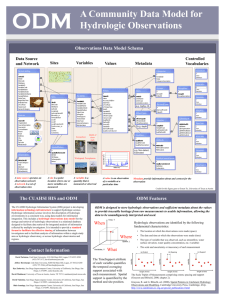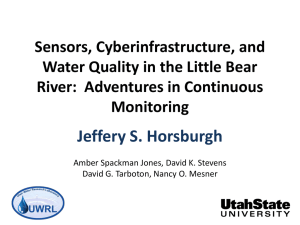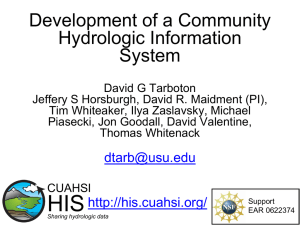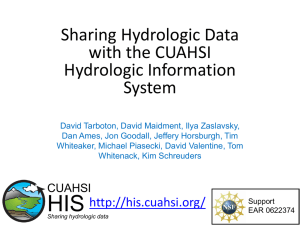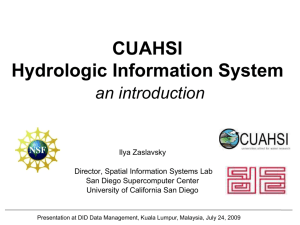Development of a Community Hydrologic Information System
advertisement
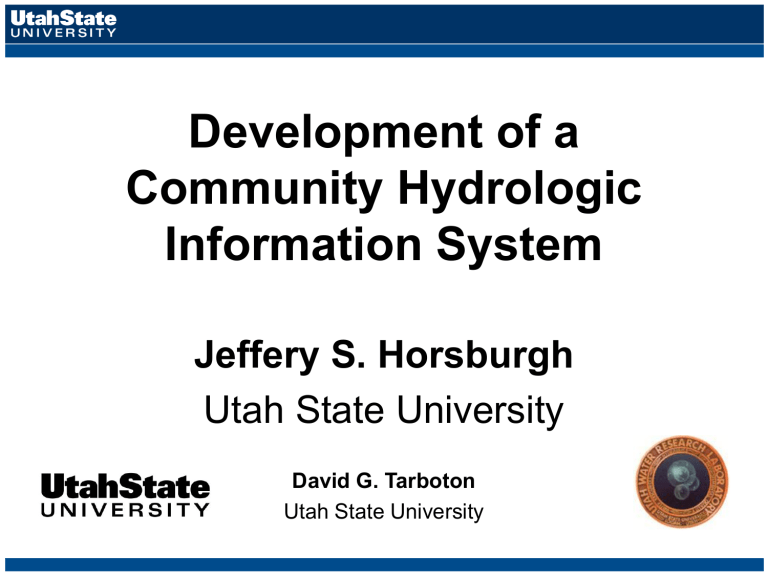
Development of a Community Hydrologic Information System Jeffery S. Horsburgh Utah State University David G. Tarboton Utah State University Hydrologic Science It is as important to represent hydrologic environments precisely with data as it is to represent hydrologic processes with equations Physical laws and principles (Mass, momentum, energy, chemistry) Hydrologic Process Science (Equations, simulation models, prediction) Hydrologic conditions (Fluxes, flows, concentrations) Hydrologic Information Science (Observations, data models, visualization Hydrologic environment (Dynamic earth) Water quantity and quality Soil water Water Data Remote sensing Meteorology Rainfall & Snow Modeling • Objective Provide access to multiple heterogeneous data sources simultaneously, regardless of semantic or structural differences between them What we are doing now … NWIS request return request return request return NAWQA request return NAM-12 request return request return request return request return NARR Slide from Michael Piasecki, Drexel University What we would like to do ….. GetValues GetValues NWIS generic request CUAHSI HIS GetValues GetValues GetValues GetValues NAWQA GetValues GetValues NARR ODM Slide from Michael Piasecki, Drexel University CUAHSI Hydrologic Data Access System USGS EPA NCDC NASA NWS Observatory Data A common data window for accessing, viewing and downloading hydrologic information Hydrologic Data Access System Website Portal and Map Viewer Information input, display, query and output services Uploads Downloads Preliminary data exploration and discovery. See what is available and perform exploratory analyses Web services interface HTML -XML WaterOneFlow Web Services e.g. USGS, NCDC Observatory data servers ODM WSDL - SOAP 3rd party data servers Data access through web services Data storage through web services GIS Matlab IDL CUAHSI HIS data servers ODM Splus, R Excel Programming (Fortran, C, VB) Web Services • A set of protocols that together provide a mechanism for machine-to-machine communication over the Internet • Advantages – Interoperability across operating systems and programming languages (XML based) – Application developers interact with web services similar to the way they interact with any other software library within a programming environment Data Sources NASA Storet Extract Ameriflux NCDC Unidata NWIS NCAR Transform CUAHSI Web Services Excel Visual Basic C/C++ ArcGIS Load Matlab Applications Fortran Access http://www.cuahsi.org/his.html Java Some operational services Data Consumption and Analysis Local Data Sources With Multiple Formats Excel Files Text Files Acces s Files Sensor Data Local Data Sources With Multiple Formats Excel Files Acces s Files Local Data Data Consumption and Analysis •Text No efficient online data delivery system •Files Disparate file formats ODM with • Different types, frequencies, etc. Web Services Sensor Data Data Mediation XML CUAHSI Observations Data Model • A relational database at the single observation level Streamflow (atomic model) • Stores observation data made at points • Metadata for unambiguous Precipitation & Climate interpretation ODM • Traceable heritage from raw measurements to usable information • Standard format for data Water Quality sharing • Cross dimension retrieval and analysis Groundwater Levels Soil Moisture Data Flux Tower Data Data Processing Applications Internet ODM and HIS in The Little Bear River Test Bed Integration of Sensor Data With HIS Base Station Computer(s) Observations Database (ODM) Internet Telemetry Network Data discovery, visualization, analysis, and modeling through Internet enabled applications Environmental Sensors Workgroup HIS Server Workgroup HIS Tools Programmer interaction through web services Managing Data Within ODM - ODM Tools • Load – import existing data directly to ODM • Query and export – export data series and metadata • Visualize – plot and summarize data series • Edit – delete, modify, adjust, interpolate, average, etc. Little Bear River Integrated Monitoring System Sensors, data collection, and telemetry network Sensors (Streamflow Water Quality Climate) Wet Chemistry Measurements Bayesian Networks to control monitoring system, triggering sampling for storm events and base flow CUAHSI HIS ODM – central storage and management of observations data Telemetry Network A B Sensor Bayes Network Central Observations Database C Site specific correlations between sensor signals and other water quality variables Constituent Bayes A Net Little Bear River at Mendon Road (4905000) Nutrient Estimates 300 B Bayesian Networks to construct water quality measures from surrogate sensor signals to provide high frequency estimates of water quality and loading C y = 2.3761x R2 = 0.6993 175 200 150 125 Residue Total Nonfiltrable; mg/L TOtal Suspended Solids (mg/L) 250 150 100 75 50 25 100 0 1980 50 0 0 15 30 45 Turbidity (NTU) 60 75 1990 Date 2000 Exogenous Variables (GIS, Land Use, Management) End result: high frequency estimates of nutrient concentrations and loadings Conclusion Advancement of water science is critically dependent on integration of water information Models Data Models: Structured data sets to facilitate data integrity and effective sharing and analysis. - Standards - Metadata - Unambiguous interpretation ODM Web Services Databases Analysis Analysis: Tools to provide windows into the database to support visualization, queries, analysis, and data driven discovery. Models: Numerical implementations of hydrologic theory to integrate process understanding, test hypotheses and provide hydrologic forecasts.


